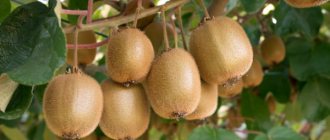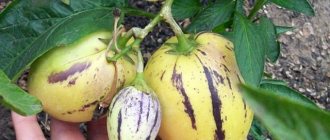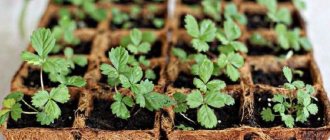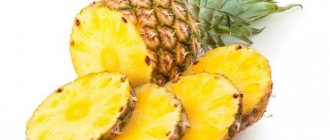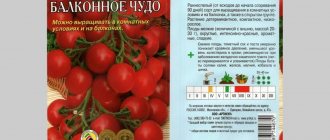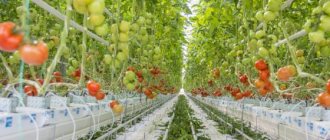Long-term communication with pepino allowed us to understand (although not completely) its biological characteristics and cultivation technology. But the main thing is that we managed to adapt a perennial shrubby semi-lignified plant, an inhabitant of the southern habitat, to our conditions and cultivate it as an annual plant in open ground, obtaining a harvest of wonderful fruits.
The agricultural technology of a new crop for us is similar to that of tomato, with the exception, perhaps, of preserving the mother plants in the winter.
Pepino, Melon Pear or Sweet Cucumber © Gavin Anderson
What is pepino
Pepino is a perennial shrub whose branches are partially woody. An adult bush can reach one and a half meters in height. Surprisingly, the closest relatives of this unusual plant are tomatoes, eggplants and potatoes. Even the flowering of pepino resembles the flowering of potatoes. Botanists classify it as a member of the nightshade family. In nature, the culture grows in Chile, Peru and New Zealand - it is grown there on a large scale and is actively used in cooking. The local population adds pepino fruits to desserts, meat dishes, sauces and soups.
The fruits of different varieties of pepino can be round or oval in shape. The color of the mysterious fruit is soft yellow, and there are purple stripes or specks along the entire fruit. Thanks to the pepino color, you will not confuse it with anything else. The size of the fruit also depends on the plant variety: the weight can range from 50 to 750 grams. If you try to describe the pepino fruit, you will find an external resemblance to the familiar pear, and a taste similar to melon, pumpkin and pineapple. That is why many summer residents call the overseas fruit “melon pear”.
If you start growing a tropical delicacy, you will be harvesting throughout the entire season: the fruits will not all ripen at the same time. As a result, you can collect 6-8 kg of fruit from one bush. From the moment the flower appears until the day the fruit is cut, 2.5 - 3 months pass. You can determine the ripeness of a fruit by its characteristic color and stripes.
Pepino fruits are very aromatic and tasty: you will be happy to taste them both raw and processed. If you want to enjoy fresh fruit, it is better to peel the skin, although it is very thin, and remove the seeds with a spoon. On average, 80% of the fruit’s weight is juicy, sweet and sour pulp, yellow or white. In addition to culinary pleasure, when eating pepino, you will also receive a replenishment of iodine balance in the body - the fruit contains a large amount of it. As you can guess from the yellow color of the melon pear, it is rich in vitamin C, and in addition, vitamins B, PP, keratin and iron.
You can store pepino in the refrigerator for 2 months - nothing bad will happen to it and, on the contrary, the longer the fruit sits, the stronger the aroma it acquires.
Description
The birthplace of this miracle is South America. Externally, it is a perennial branched shrub, up to 1.5 meters high. The leaves are elongated, up to 15 cm long. But the most interesting thing is the fruit! They have a beige or slightly yellowish tint, and weigh up to 800 grams. The shapes are pear-shaped, oval and round. This is where the comparison of this fruit with vegetables such as pumpkin and cucumber came from! However, this similarity is only external. The taste is sweet, with sour notes and a bright melon aroma.
How to grow pepino at home? It's actually very simple. First we start by choosing a variety.
Conditions for growing pepino
In our country they began to grow pepino quite recently. This can be done on a balcony, terrace, just on the windowsill in an apartment and, of course, in any type of greenhouse - the crop is heat-loving and needs a special microclimate.
The first and main rule is that the air temperature should never fall below +13°C. Optimal conditions for comfortable growth:
- temperature +20 - +25°C during the day throughout the entire growing season;
- absence of sudden temperature fluctuations;
- high air humidity (about 75 - 80%);
- constantly moist soil;
- absence of strong wind or draft (the plant simply breaks due to the fact that its roots are located almost on the surface of the soil).
It is not difficult to create such conditions in a greenhouse, especially if it is equipped with a heating/cooling system. However, pepino is also grown in open ground. There are more difficulties here. Although the crop is tropical, it cannot tolerate too high temperatures. Therefore, in the hot summer, when the thermometer readings approach +30°C, the pepino flowers will fall off and the fruits will not set. But if in September - October the weather is mild, the plant will delight you with abundant flowering and fruits.
You can grow a miracle fruit by planting seeds or sprouted cuttings. Both methods are good - you should choose the more convenient one.
Harvesting the melon pear
When to Harvest Pepino
It is necessary to have time to collect the fruits, since overripe ones will become less tasty. Also, transporting them will become difficult. Remove the melon pears when they are the size of a goose egg and turn creamy or yellowish in color. They can be stored for several months at a temperature of 4-5 °C.
Americans and Japanese prepare desserts and fruit salads from the fruits of the sweet cucumber. In New Zealand they are used similarly to vegetables: preparing soups, sauces, side dishes for meat, fish, and seafood. Pepino can also be preserved in sweet syrup, salted, made into jam, jams, compotes, frozen and dried.
Growing pepino from seeds
You can buy seeds at a specialty store or prepare them from a ripe fruit. Planting material germinates well at home and has a high germination rate. However, you should understand that not every variety will produce healthy young plants when grown from your own seeds. Hybrids with this method of propagation may produce late flowering or uneven fruits - the variety will simply degenerate.
The most popular hybrid varieties, bred specifically for growing exotic fruit in Russian latitudes, are “Ramses” and “Consuelo”. In total, breeders around the world have already created more than 25 varieties of melon pear.
In order for the plants to be sufficiently strong before the season of moving to the greenhouse or balcony, planting should be carried out already in the first half of February. For germination you will need light, moist and well-loosened soil (the crop needs oxygen access to the roots). You can purchase soil for growing tomato seedlings - it contains all the microelements necessary for a melon pear.
- Wrap the seeds in a damp cloth and place in a dark and very warm place. After a few days, when signs of germination become noticeable, they can be planted in the ground.
- Plant the seeds in the prepared tray: sprinkle them on the surface of the soil and lightly crush them with earth.
- Cover the tray with film or glass - this will help create a greenhouse effect that will speed up the germination of pepino seeds.
- Place the box with seedlings in a room where the temperature will be +26 - +28°C. It is important that the temperature is constant.
- After about a week you will notice the emergence of seedlings. Then you can remove the film (glass) - there is no need to cover the seedlings now.
- Plants should develop until 2-3 leaves appear. At this time, water them and monitor the temperature in the room.
- When the leaves appear, the pepino seedlings are ready for picking. Transplant only the strongest shoots into separate pots. Moreover, to prevent bacterial diseases, first water the soil in the pots with a weak solution of potassium permanganate.
- After picking, cover the pots with melon pears again with film. This will maintain high air humidity around the young plant, and it will be easier for it to take root in a new place.
- Culture will develop slowly in the first month of life - this is normal and should not cause you concern. To speed up growth, add light to pepino seedlings.
- By the time of transplantation to a permanent place, the pepino will reach 10 cm in height and will already have 8-9 leaves.
Growing pepino from cuttings
A more reliable and at the same time simpler way to propagate the pepino bush is by cuttings. The cutting is taken from an adult bush that has survived the winter well. The procedure can be carried out as early as the end of February.
- cut off the part of the shoot that has 7 leaves;
- remove the bottom couple of leaves and cut the next 3 in half - this way the cutting will lose less moisture and take root faster;
- place the cuttings in a jar of clean water at room temperature (the leaves should not be in the water);
- within a week the cuttings will sprout roots 1.5–2 cm long.
Experienced gardeners and gardeners claim that pepino takes root very well - all cuttings develop roots without additional fertilizing or growth stimulants.
So, when the roots of future bushes have grown by 2 cm, they need to be immediately planted in the ground. To grow pepino (as we already mentioned), a tomato mixture is suitable. Take small pots or simple plastic cups with holes in the bottom to drain water, and plant the cuttings in them. It is very important that the soil is loose: the roots of the crop need access to oxygen.
Soil preparation and planting pepino
In order for the melon pear bush to feel great, it needs to be planted in light soil with neutral acidity. It’s good if garlic, beans, onions or cucumber grew on the site before pepino. Even in the fall, after harvesting the predecessor crop, the ground needs to be dug up and cleared of weeds and root remains.
In the spring, when it’s time to plant our exotic fruit, proceed as follows:
- loosen thoroughly;
- make rows with a distance of at least 70 cm between them;
- the planting depth should be small;
- add organic fertilizer - compost (4 kg per square meter);
- water the soil;
- plant pepino seedlings in a checkerboard pattern, so that there is a gap of 50 cm between plants;
- It is advisable to plant in the evening;
- after planting, the crop needs to be watered, and then watered again every few days (do not allow the soil to dry out);
- The beds must be mulched with dry soil.
The only questions that remain are when and where to plant tropical pepino. Of course, it is better to plant in a greenhouse: this will allow you to plant earlier (in mid-April), prolong the growing season of plants and get early fruits.
If there is no greenhouse on your site, then you can plant it in open ground, but a little later - in May, when the probability of night frosts is minimal (these dates are different for each region). However, it is advisable to build a small film shelter for the plant in the garden bed for the first time in order to protect it from the wind and possible cold snap. The simplest version of the protective structure is reinforcing wire in the form of an arch over the bed, which is covered with a dense film. Do not forget that during the day the greenhouse must be opened to ventilate the bed. The shelter can be removed when the weather becomes consistently warm and the bush enters the active growth phase.
If you grow pepino at home in a pot or tub, then move the plant to the balcony on warm days or open the windows - the culture needs sunlight and fresh air.
Bloom
At the beginning of June, despite the hot weather, Pepino gathered buds and prepared to bloom. This was a pleasant surprise for me and another reason to start searching for information again and find out how to help the plant set fruit.
Melon pear buds
The information studied made it clear that there is very little chance that the pepino will bloom and, as a result, set fruit. This plant does not like heat, and at the end of June, in a greenhouse, it almost never happens any other way. That is, there was a great chance that the pepino would drop all the flowers. My solution was the drug “Ovary”, it stimulates fruit formation. From time to time I treated the flowers with this preparation.
Pepino flowers, similar to potato flowers
Also, one of the ways to help the plant set fruit is to self- pollinate with an ordinary fluffy brush.
. To do this, take pollen from one plant with a brush and carefully transfer it to another. I didn't miss this method either.
Formation of a pepino bush
It is very important not to miss the moment and carry out tying and pinching - forming a plant bush.
So, although the pepino bush is quite strong, it can break under the weight of the filling fruits. In addition, it has been noticed that a plant that lies on the ground stops blooming and bearing fruit. Installing a trellis - a convenient support for the plant - will help to avoid such troubles.
When the plants are planted, drive several strong supports along the bed (this can be pipes, fittings or wooden beams). The distance between supports is 2-3 meters. And their height above the ground is 70-80 cm. Next you will need a strong wire or wire. Pull it between the supports at a distance of 20-25 cm from each other. The resulting “strings” should under no circumstances sag.
Already 20-25 days after planting in the ground, the pepino bush should begin to be tied up and formed:
- remove all shoots of the plant, leaving the three strongest shoots - they will become the basis of the bush;
- tie the shoots to the bottom “string” of the trellis: the central shoot is vertical, and the side shoots are tilted slightly to the sides;
- as the stems grow upward, tie them so that they are positioned vertically, resting on the trellis - this will allow the plant to reach for the sun and gain strength for the development of fruits;
- all fruitful branches extending from the three main ones can not be tied up, but simply “hung” on the threads of the trellis so that they do not bend to the ground;
- when you notice that stepsons (additional shoots) are forming on the fruit-bearing branches, cut them off so that they do not draw the nutrients the pepino needs for the ripening of the fruit;
- The bush is very prone to the formation of stepsons - you need to remove them every week, otherwise instead of a harvest you will only get branches.
Pepino: regular care
- Regularly loosen the soil and remove weeds between the beds.
- Water your exotic bush so that the soil remains moist at all times.
- Check pepino leaves and stems for pests. Affected areas of the bush must be treated immediately to prevent the spread of the disease.
- Feed the bushes with organic fertilizers (mullein in a ratio of 1:10): the first time - after rooting of seedlings and the beginning of active growth, the second time - at the stage of fruit formation. Do not forget to water the crop immediately after fertilizing.
Preparing pepino mother plants
In order to get young and healthy bushes next year, you should start preparing in August. To do this, stepchild plants are germinated from cuttings of the main bush. If you start preparing in the second half of summer, then young pepino plants will be prepared for the onset of cold weather - it will form a full-fledged root system.
How to grow stepchild plants:
- In July, trim the shoots from the bush and root them.
- Plant young bushes next to the mother plant - this will make it easier for them to develop. The main bush will provide protection from the sun and excessive evaporation of moisture.
Papaya
Breadfruit - where it grows and why it is called that
Papaya is a close relative of pepino. However, the way they grow is very different. The fruits are similar in taste.
Not long ago, research was conducted into whether papaya seeds can be eaten, and scientists came to unexpected results: they can be used as a seasoning and dietary supplement. Crushed papaya seeds taste like black pepper.
Papaya in nature
Flower growers are gradually mastering ways to plant papaya at home. A large number of life hacks have already been invented on how to grow papaya from seeds, what conditions it prefers and whether it can bear fruit. The process is certainly fun and rewarding.
Wintering young pepino plants
By the end of September, when the night temperature begins to drop, the shoots will already have taken root. Do not allow the plant to tolerate temperatures below +13°C, otherwise all growth processes in the stems will stop.
- dig up young plants along with a clod of earth (it is important not to injure the root system);
- place them in a box or flower pots (there must be drainage and a layer of ready-made soil mixture for growing tomatoes at the bottom);
- if the air temperature allows, leave the box with plants outside for several days - this will make it easier for them to cope with a change of place;
- then bring the pots of pepino into the living room and place them on the window sills (it is advisable that the windows do not face north);
- In winter, care for pepino like other indoor plants, and in April it will be ready for planting in the ground and bearing fruit.
Separation into varieties
By the beginning of April, Pepino had grown a good amount of green mass and it became visually noticeable that we had 2 varieties. One of the varieties had leaves that looked like potato leaves (pepino is a close relative of potatoes and eggplant), while the second had smooth and straight leaves.
There are four plants left. Two of one variety and two of another.
Pepino leaves
What was the problem?
Plants of the same variety had different leaves. All pots and jars were always labeled, nothing fell or got mixed up.
Since both varieties are from the same agricultural company, there is an assumption that the seeds could have been mis-sorted or confused.
PS Even after receiving the fruits, it was not possible to determine the variety. The descriptions of both varieties on the bags are almost identical and do not describe the obvious differences that the varieties have.
Pepino: pests and their control
All insects familiar to gardeners can harm exotic shrubs: whiteflies, aphids, spider mites and the Colorado potato beetle. You can treat plants against pest attacks in the same way as other crops in your greenhouse. To avoid using chemical insecticides, make a decoction of tobacco, yarrow, onion peel or garlic and spray it with pepino from a spray bottle once a week. This will help get rid of the problem, but will also preserve the environmental friendliness of the fruits in your garden. Before sending mother plants for winter, be sure to treat them with pest control products.
As for chemicals, there are no special products for treating pepino. Insecticides to protect tomatoes or eggplants are suitable for you. However, pepino can become hypersensitive to chemicals and even die from exposure. Therefore, test the product on a small shoot before treating the entire plant.
Beneficial features
Pepino contains quite a lot of iodine, which makes it possible to recommend this product to people with thyroid problems. This fruit contains potassium, which is useful for reducing blood pressure and helps in the treatment and prevention of diseases of the cardiovascular system . Since pepino has low acidity, it can be safely consumed by people who suffer from gastrointestinal problems .
If a person eats 100 g of this fruit, his body will receive 80 kcal.
The skin of these fruits contains anthocyanins, which have antimicrobial, anti-inflammatory and anticancer effects . Pepino contains fiber, which has a positive effect on the digestive system and helps cure or will serve as a preventive measure for constipation . Since the fruit consists of almost 93% water, it can be classified as a dietary product that can be consumed during weight loss and obesity.
